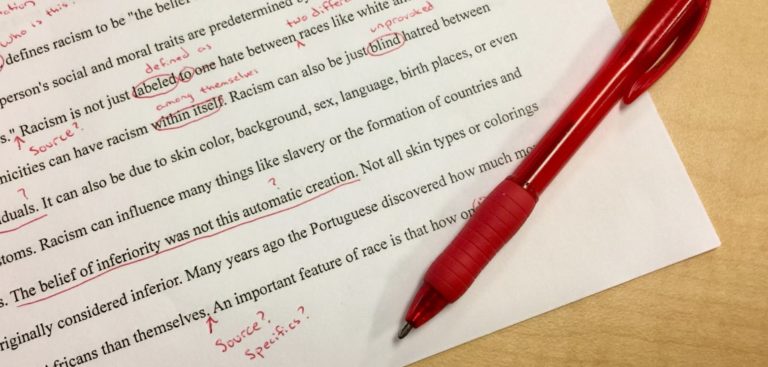Blog:
In other words
15 tips to proofread your own writing—Part 3
In Part 1 and Part 2, I shared with you my first 10 tips on proofreading your own writing.
This article is the third and final part of the series with practical advice on spotting errors and inconsistencies in your documents. Specifically, I’ll explain how using tricks like reading your text out loud, reading it backward, and changing displays and layouts can be effective ways to polish your draft.
I always apply these methods to help me get a different perspective on my texts. I hope they work for you, too!
Tip #11: Read your writing out loud
You may have heard this piece of advice before:
Read your writing out loud. And do it s-l-o-w-l-y. You’ll be amazed at the number of errors you pick up on.
Why is that?
- By reading out loud, your brain processes the information on the screen differently compared to when you read silently.
- You probably can’t speak as fast as you can read. By reading aloud, you automatically read more slowly and can more easily identify errors, redundancies, and missing words.
- Sometimes reading aloud makes you see—well, hear—where the flow and writing style need to be improved.
- Problematic areas will stand out when you read aloud, and you’ll pick up on other issues readers might stumble over.
Here are some examples of imperfections you can find by reading your text aloud:
- Repeated words (a common one is “the the”)
- Missing words
- Too long or convoluted sentences
- Grammatically incorrect phrases
- Structural issues
- Unwanted alliterations (“The cold can cause canker sores”)
- Contradictions
- Inappropriate tone or writing style
Try it yourself. Pick a piece of your writing and start reading it aloud. For an even better result, read from a device that’s different from the one you’ve been working on—ideally, one with a different screen size (see also Tip #13).

Read and speak deliberately and concentrate on segments that sound particularly convoluted or don’t get the message across.
What do you notice that you would like to change?
Are some sentences too long?
Do you pick up on inelegant phrases you didn’t notice before?
PRO TIP: When reading your text aloud, read slowly. Don’t just pay attention to how words are spelled, but notice how they sound, too. Do some sentences sound clunky? Do you find yourself having to pause mid-sentence because you run out of breath?
Tip #12: Read your text backward
Sounds weird, doesn’t it? But it actually works.
Start with the last sentence of your text and work your way back to the beginning, reading one sentence at a time.
How is this useful for proofreading?
Remember Tip #2, where I said that you tend to skip over errors because you know your own writing too well? You’ve spent so much time working on your text that you probably know parts of it by heart.
This is problematic for proofreading because you lose the fresh perspective necessary to identify problem areas.
By reading backward, you’re forcing your brain to pay attention because the text seems different.
This approach doesn’t work as well for spotting big-picture or flow issues because you’re reading your arguments in reverse order. However, this method is effective for sentence-level revision.
Try it.
PRO TIP: Read the last sentence of your writing first and work your way back to the beginning. Ensure that you read each sentence slowly and carefully. Think about whether it makes sense as a whole before moving on to the next—well, previous—one.
Tip #13: Change displays, layouts, and fonts
When you’ve been working on the same document with the same layout, font type, line spacing, etc., your eyes get used to the text and the way it’s displayed, which makes it harder to spot mistakes.
Changing how your text is displayed on a page will make it seem almost like a new piece of writing.

Here are some suggestions regarding display and layout changes to proofread your work:
- Use another device—ideally, one with a different screen size: The line breaks will appear in other places than your eyes are used to, so you can more easily detect redundancies and typos.
- If you don’t have another device, change the page layout: If you’ve been writing in a single column (as most of us do), switch to two or even three columns, making it look more like a newspaper article. Just like when you’re using a different screen, your text will appear much more condensed this way, with more frequent line breaks. It makes for a more active way to read and can be surprisingly effective.
- Zoom into the document while you proofread—and I’m talking a level of at least 250%! The enlarged letters allow only a few lines to be displayed at a time and really stand out. You can also use a ruler to help you focus on one line at a time.
- Use a font type and size that’s noticeably different from what you’ve been using. For example, if you’ve been writing in a serif font (such as Times New Roman) to create your draft, change it to a sans serif font (such as Arial) when you revise it. The new appearance can help you to spot errors more easily.
Using the trick of changing the display and layout might be particularly appealing to those who want to save paper and ink (see also Tip #14).
PRO TIP: Give your eyes a fresh perspective by proofreading on another display and changing your document’s text size and font type. The words are the same, but the new appearance makes it easier for your eyes to focus on the details. Don’t forget to change the layout back to the required style if you have to submit your document in a particular format.
Tip #14: Proofread on a hard copy
This one has been tried and tested—and it works!
Print out your document and arm yourself with a pen to proofread your work. You’ll be surprised at what jumps out at you that you didn’t notice onscreen before.
Why does it work?
Proofreading on a hard copy is effective because:
- Your eyes can get tired when you look at a screen for too long.
- The new perspective on paper makes it easier to identify errors.
- You can focus more on the content and big-picture aspects by placing the sheets side by side and looking at entire sections or chapters all at once without losing scale.
- The broad overview also helps to detect formatting and layout issues more easily.
- A few sheets of paper weigh less and are less valuable than a laptop, which makes them more practical for working in other locations, such as on a train or in another public place. The new setting can give you a new perspective and a fresh mindset.
Also, there’s just something about holding a pen and paper in your hand, isn’t there?

While I find this proofreading tip extremely useful, I’m also conscious of the ink and paper it takes to print out documents—especially for more comprehensive works.
If you’re concerned about using too many resources with this approach, I suggest the following:
- Reserve this method for your most important documents—those which must be error-free, such as job applications.
- Keep this step for your last proofreading pass after you’ve used all other methods to find errors and inconsistencies, such as reading your text out loud (Tip #11) and backward (Tip #12), viewing it on different screens, and changing the font type and size (Tip #13).
- Print only the most important sections of your document. For example, you could omit the table of contents and the bibliography of your academic work, which can take up several pages. (You still need to proofread them, though!)
- Print your work double-sided (duplex) to save paper and in black and white (grayscale) to save ink.
PRO TIP: Proofreading your work on a hard copy can help you weed out the last few errors and identify formatting or layout issues. To be more environmentally conscious, print only the most important paragraphs or chapters and select grayscale and duplex printing to conserve resources.
Tip #15: Know which rules and writing conventions apply today (and what has changed)
Last but not least: Know the rules—know which “rules” are considered guidelines and know which of the actual rules no longer apply at all.
Because every language evolves. Constantly.
You need to know the following when you proofread your work:
- Which spelling, grammar, and punctuation rules apply now? What has changed since your school days?
- What are the current writing conventions of your chosen language and dialect? Are you sure that the words you’re using mean what you think they mean?
In the following, I go into these two topics in more detail:
Which spelling, grammar, and punctuation rules apply?
Do the rules you learned in school still apply today, or have some of them changed?
Take German spelling and punctuation rules, for example.
Someone born in Germany, say, in 1978, has had to adapt to changes in written German several times during their lifetime already.
This person would have just graduated from high school when the German orthography reform was introduced in 1996—with several significant changes to German spelling rules. This was followed by an amendment to the reform only 8 years later (in 2004) and another one just 2 years after that (in 2006).
That’s a lot of changes!
Some people still get confused about the old and new rules and which “rules” are guidelines (such as optional commas in a sentence). I can usually tell someone was born before 1990 when they spell a word the old way. For example, “Schloß” (castle) was the correct spelling until 1996. The new spelling since then has been “Schloss”.
As they say, old habits die hard—especially ones we acquired in our youth. (Don’t you hate it when your language usage reveals your age?)
Before you proofread your work, ask yourself whether you have a firm grasp of the current spelling, grammar, and punctuation rules in your language. If you have any doubts, look it up or ask a language professional.
What are the current writing conventions of your chosen dialect?
Not all English and German dialects are the same.
The English language can be tricky because there are several dialects (British, Irish, American, Canadian, Australian, Caribbean English, etc.) that have been evolving and diverging for centuries. Some English words mean one thing in a particular part of the world but have a completely different meaning in another region (see also Differences between British and American English).
The same applies to German and its many dialects (Standard High German, Swiss German, Austrian German, etc.): Not all words are spelled the same, and not all words are used in the same way in the different dialects and regions.
Whether you’re writing in English or German: You need to know the common style conventions, idioms, and expressions of your chosen dialect.
To be on the safe side, use a dictionary to check whether a term you’re using in your text can have multiple meanings or tends to be misused. The New Oxford Dictionary and Merriam-Webster’s Dictionary are great resources for this.
But there’ll be times when you don’t have the time to check all potentially problematic terms.

A professional proofreader or editor is another excellent resource: Our job literally involves knowing the current rules and keeping up with changes in writing conventions.
So, if you don’t want to worry about the writing conventions in your chosen English or German dialect, I can help.
PRO TIP: You can’t proofread effectively if you don’t know the rules. Stay informed about any changes to the rules and writing conventions of your language. If you are overwhelmed or tend to confuse old rules with new ones, a professional language expert can help you.
There you go!
Use these 15 proofreading tips to help you pick up on errors and inconsistencies in your own writing.
Doing so will reduce the chance of errors remaining in your document and leave you with more money in the bank at the professional proofreading stage.
That said, a language expert will undoubtedly spot something you missed—no matter how often and carefully you’ve revised your text.
Do you need to have your text professionally proofread or edited?
Whether it’s an academic paper or essay, a thesis, dissertation, job application, blog article, or another piece of creative writing: I can help you polish your writing and make it stand out—in a good way!

Christina Stinn is a professional translator, proofreader, and editor with a background in ecological research and experience in publishing peer-reviewed articles in academic journals. She is a Professional Member of the Chartered Institute of Editing and Proofreading (CIEP) and has a M.Sc. degree in International Nature Conservation. So far her work has included fiction and non-fiction books, academic journal articles, and marketing materials in English and German. She loves working with clients who strive to bring their writing to the next level and enjoys taking part in their journey. Find out more
YOU MIGHT ALSO LIKE:



